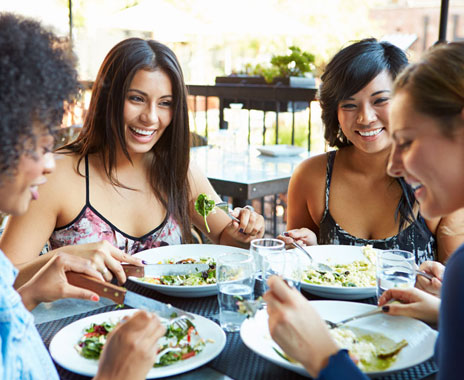How do restaurants measure customer loyalty? Or, perhaps more importantly, how do they create it? With new players continuously entering the market, quick-serves are always on the hunt for ways to engage with consumers—not just to get them into the restaurant initially, but also to keep them coming back.
In today’s competitive market, technology solutions are a key investment to remain relevant and drive revenue. The average consumer spends more than three hours per day in mobile apps alone, creating ample opportunity for marketers to gather and leverage data from various channels to target them better. The problem? Restaurants struggle with organizing and leveraging that data in a meaningful way.
What makes a great loyalty program?
Most restaurants are already collecting customer data through a variety of sources—everything from social programs, online ordering, mobile wallet payments, a restaurant-specific app, and even the brick-and-mortar POS system. The challenge comes when trying to create a single view of the customer, which is vital to converting those insights into decisions, actions and targeted campaigns and offers. Restaurants with the most effective loyalty programs can quickly organize their data into a singular view to begin to track customer behavior and make informed decisions.
When it comes to executing on those decisions, most brands today are familiar with the concept of leveraging marketing automation tools to reach customers, but few have truly mastered it. The restaurants leading the loyalty pack though are the ones who are conquering behavior-driven campaign execution. They have the ability to trigger campaigns to individual customers based on historical, locational and behavioral data.
Consider, for example, the following statistics: 83 percent of consumers pick a dining location within three hours of a meal, and 57 percent make the decision within an hour. And when they’re picking a location to eat, 60 percent of consumers only use their mobile device to help with their decision. With the ability to set up promotions through text notifications, in-app notifications or email campaigns based on past purchases, timing, behavior, loyalty status or points, there is a significant edge to be gained when it comes to retargeting, as well as upsell and cross sell.
Getting customers into a restaurant is the first step in the process, but restaurants also need to keep customers wanting to come back. Brands with the most well thought out loyalty strategies are the ones who connect customers to their restaurant. This connection can take many forms. One of the most sophisticated is closed loop reward management, in which a restaurant will deliver single-use, personalized offers that can be redeemed at the restaurant POS system. Closed loop rewards create a two-way benefit: the restaurant gains insight into each individual customer’s behavior, connecting their digital activity to brick-and-mortar actions, and customers receive more targeted and relevant offers based off their profile and personal preferences—even if they pay in cash.
The ability to provide targeted offers, such as unique content or personalized product recommendation delivered when the customer is in the restaurant, at the moment of impact is another vital component for increasing engagement and loyalty. Particularly when it comes to “Super Heavy Users”—a brand’s most loyal customers—there is an opportunity for additional revenue that can be forgotten in pursuit of attracting new customers. Restaurants with leading loyalty programs are beginning to leverage machine learning algorithms to take historical purchase data and calculate the next best offer, or most likely to purchase products for their pre-existing customers.
Restaurants with the strongest loyalty programs
Leveraging brand identity, the mobile device and the key components of a great loyalty program, there some restaurants have emerged as leaders when it comes to creating meaningful engagement. Their ability to attract customers to their brand and loyalty program is clearly reflected in the numbers. Below are four of the most effective and buzzworthy quick-service loyalty programs today.
Starbucks
MyStarbucks Rewards is lauded as one of the best mobile experiences out there, and now consists of more than 13 million active members. The key for Starbucks is that it’s loyalty program is simple, easy and convenient. Mobile payments and mobile orders now make up 7 percent of total Starbucks orders in the U.S—that’s a 16 percent increase YOY.
Panera Bread
Panera offers a card-based loyalty program, and rewards its customers with free food and bakery items, invitations to special events, recipe books and more. MyPanera has 21 million active members, and is making the most of the 30 percent of millennials that prefer earning points based on the money they spend at quick-serves. A whopping 50 percent of company transactions occur on MyPanera cards.
Dunkin’ Donuts
Fifty-two percent of millennials participate in loyalty programs offered by coffee shops, and as of 2016, Dunkin’ Donuts had captured more than 7 million of them as active members of its DDPerks rewards program.
Chick-fil-A
Taking the path less travelled, Chick-fil-A uses an “invitation-only” loyalty model to give its loyal customers the most exclusive rewards. The “A List Loyalty Program” is offered in less than half of the company’s 2,000 restaurants, and its loyal customers have helped Chick-fil-A achieve the highest Customer Satisfaction rating, as well as average restaurant sales of $3.1 million.
Managing customer segmentation, executing based on behavior and delivering engagement across channels is a challenge for restaurants at any scale. But with a sophisticated approach to loyalty marketing, there’s a real opportunity to meaningfully increase customer lifetime value. By taking a fresh look at the experiences customers are getting from those restaurants leading the pack, there’s a clear path forward for brands willing to nurture the relationships with their customers.













